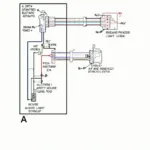The OBD2 code P1637 is a common issue that can be frustrating for car owners. This comprehensive guide provides everything you need to know about the P1637 code, from its meaning and causes to diagnostic and repair strategies. Understanding this code will help you address the underlying problem effectively and get back on the road.
What Does OBD2 Code P1637 Mean?
The OBD2 code P1637 typically refers to a “Powertrain Control Module (PCM) Internal Circuit Malfunction.” This essentially means there’s a problem within the PCM itself, the car’s central computer. The PCM controls a vast array of functions, from fuel injection and ignition timing to emissions control and transmission shifting. A fault within the PCM can disrupt these crucial operations, leading to various drivability issues.
Common Causes of OBD2 Code P1637
Several factors can trigger the P1637 code. Identifying the root cause is crucial for effective repair. Common culprits include:
- Faulty PCM: Sometimes, the PCM itself is defective due to internal component failure.
- Wiring Issues: Damaged, corroded, or loose wiring connecting to the PCM can disrupt communication and trigger the code.
- Low Battery Voltage: A weak or dying battery can cause voltage fluctuations that affect the PCM’s operation.
- Software Glitches: In some cases, a software bug within the PCM’s programming can lead to the P1637 code.
- Grounding Problems: A poor ground connection for the PCM can disrupt its functionality.
Diagnosing OBD2 Code P1637
Diagnosing the P1637 code requires a systematic approach. Here’s a step-by-step guide:
- Retrieve the Code: Use an OBD2 scanner to read the trouble codes stored in the PCM. Confirm that P1637 is present.
- Inspect the Battery: Check the battery voltage to ensure it’s within the specified range. A low battery can cause various electrical issues, including PCM malfunctions.
- Check Wiring and Connectors: Carefully examine the wiring harness and connectors leading to the PCM for any signs of damage, corrosion, or looseness.
- Verify Ground Connections: Ensure the PCM has a proper ground connection. A faulty ground can disrupt its operation.
- Consult Technical Service Bulletins (TSBs): Check for any relevant TSBs issued by the vehicle manufacturer. These bulletins often address known issues and provide specific diagnostic and repair procedures.
How to Fix OBD2 Code P1637: Repair Strategies
Once you’ve identified the cause of the P1637 code, you can implement the appropriate repair strategy. Here are some common solutions:
- Repair or Replace Wiring: If damaged or corroded wiring is found, repair or replace the affected sections.
- Address Battery Issues: Charge or replace a weak or dying battery.
- Update PCM Software: In some cases, a software update from the vehicle manufacturer can resolve software glitches within the PCM.
- Repair Ground Connections: Clean and tighten any loose or corroded ground connections.
- Replace the PCM: If the PCM itself is determined to be faulty, it may need to be replaced. This often requires programming the new PCM to match the vehicle’s specific configuration.
What if the P1637 Code Returns?
If the P1637 code returns after repairs, it’s essential to re-evaluate the diagnostic process. Double-check all connections and ensure the repair was performed correctly. It may be necessary to consult a qualified automotive technician for further diagnosis and assistance.
“A thorough diagnostic approach is crucial when dealing with the P1637 code. Don’t jump to conclusions; systematically eliminate potential causes to pinpoint the root of the problem,” advises John Smith, Senior Automotive Diagnostic Technician at Advanced Auto Solutions.
Conclusion
The OBD2 code P1637 indicates a problem within the PCM’s internal circuitry. Understanding the causes and diagnostic procedures for this code is vital for effective repair. While some fixes can be performed by DIY enthusiasts, more complex issues may require professional assistance. Addressing the P1637 code promptly will help prevent further complications and ensure the smooth operation of your vehicle.
FAQ
- Can a low battery cause the P1637 code? Yes, a low battery voltage can disrupt the PCM’s operation and trigger the P1637 code.
- Is it safe to drive with the P1637 code? While driving might be possible, it’s recommended to address the issue promptly to prevent potential drivability problems or further damage.
- How much does it cost to replace a PCM? The cost varies depending on the vehicle make and model, but it can typically range from a few hundred to over a thousand dollars.
- Can I replace the PCM myself? Replacing the PCM can be a complex procedure that often requires specialized tools and programming. It’s generally recommended to have it done by a qualified technician.
- What are some other codes related to the PCM? Other PCM-related codes can include P0600, P0601, P0602, P0603, etc. Each code represents a specific malfunction within the PCM.
- Can an OBD2 scanner clear the P1637 code? Yes, a scanner can clear the code, but this only temporarily erases the code from the memory. The underlying issue must be addressed for a permanent fix.
- What is a Technical Service Bulletin (TSB)? A TSB is a document issued by the vehicle manufacturer to address known issues and provide diagnostic and repair guidance to technicians.
For further support, contact us via WhatsApp: +1(641)206-8880, Email: cardiagtechworkshop@gmail.com or visit us at 789 Elm Street, San Francisco, CA 94102, USA. We have a 24/7 customer support team ready to assist you.
